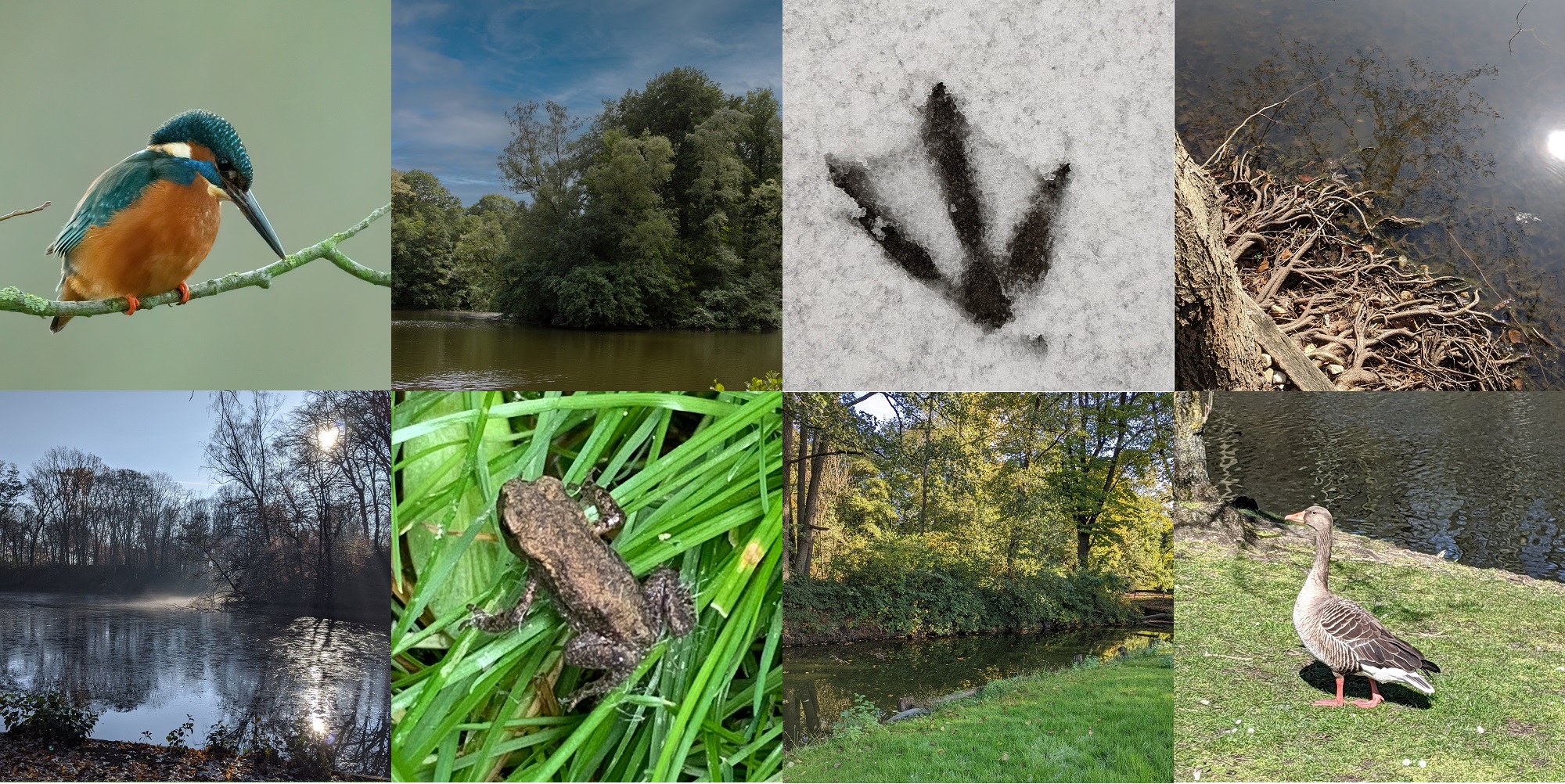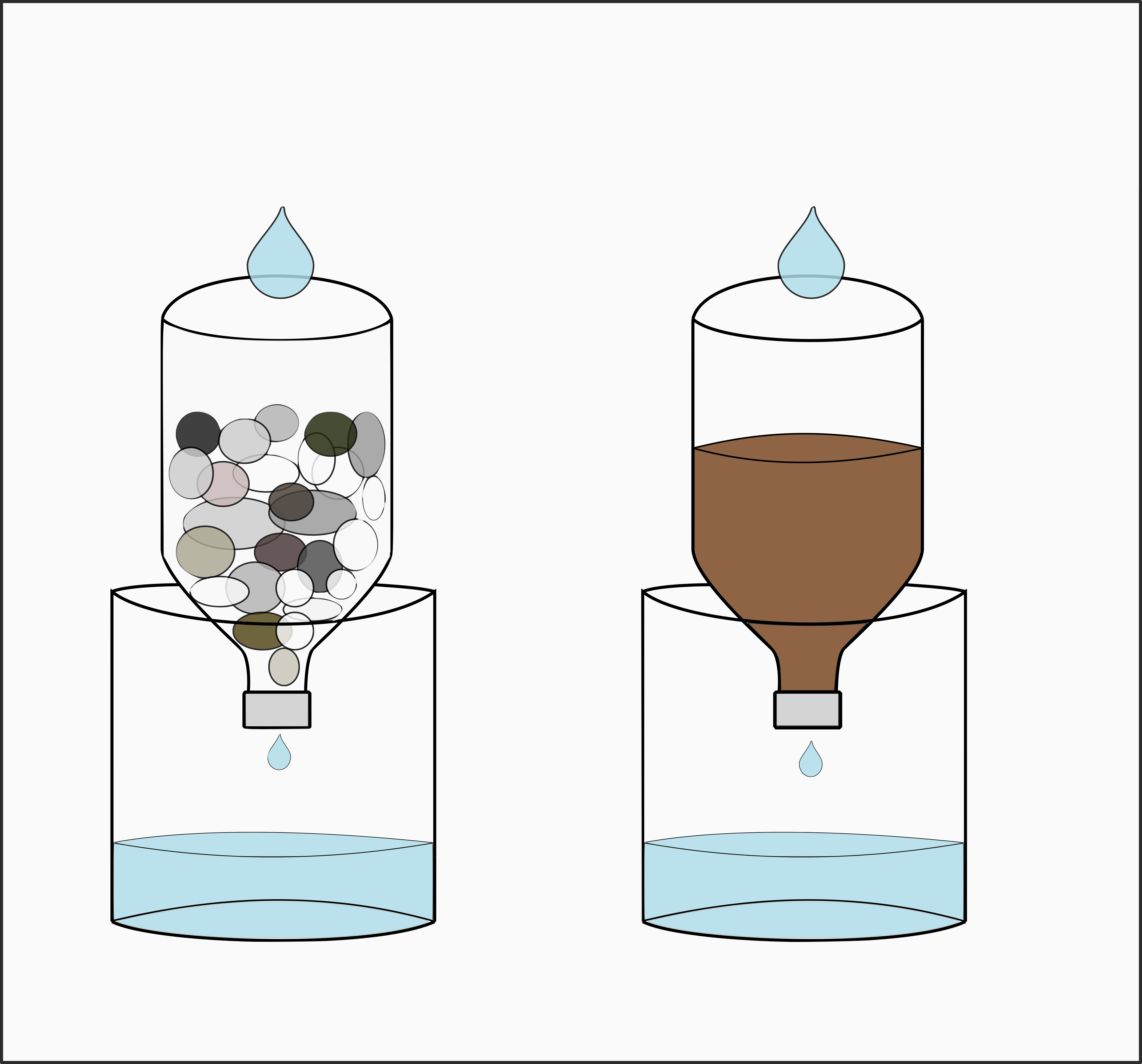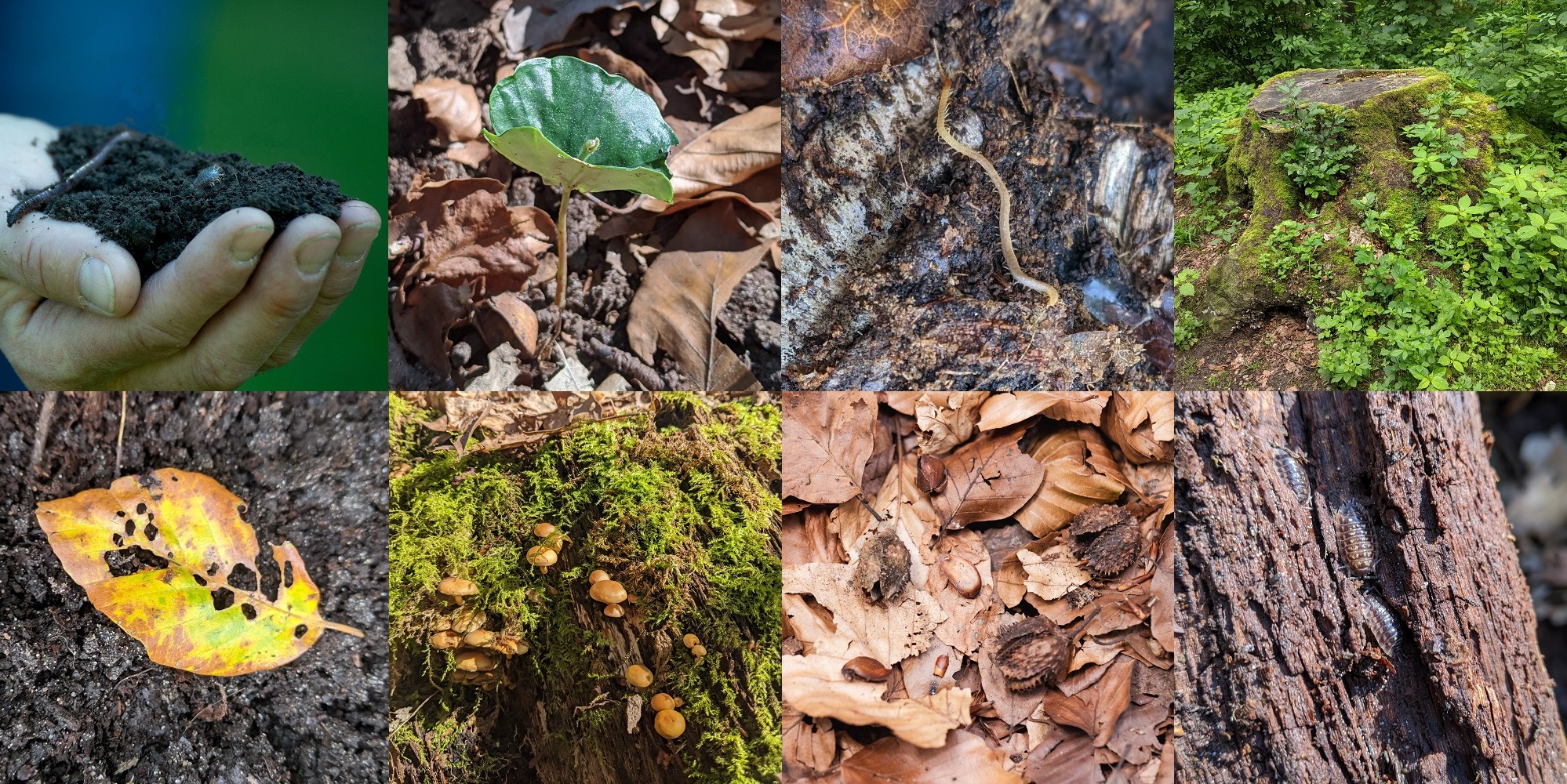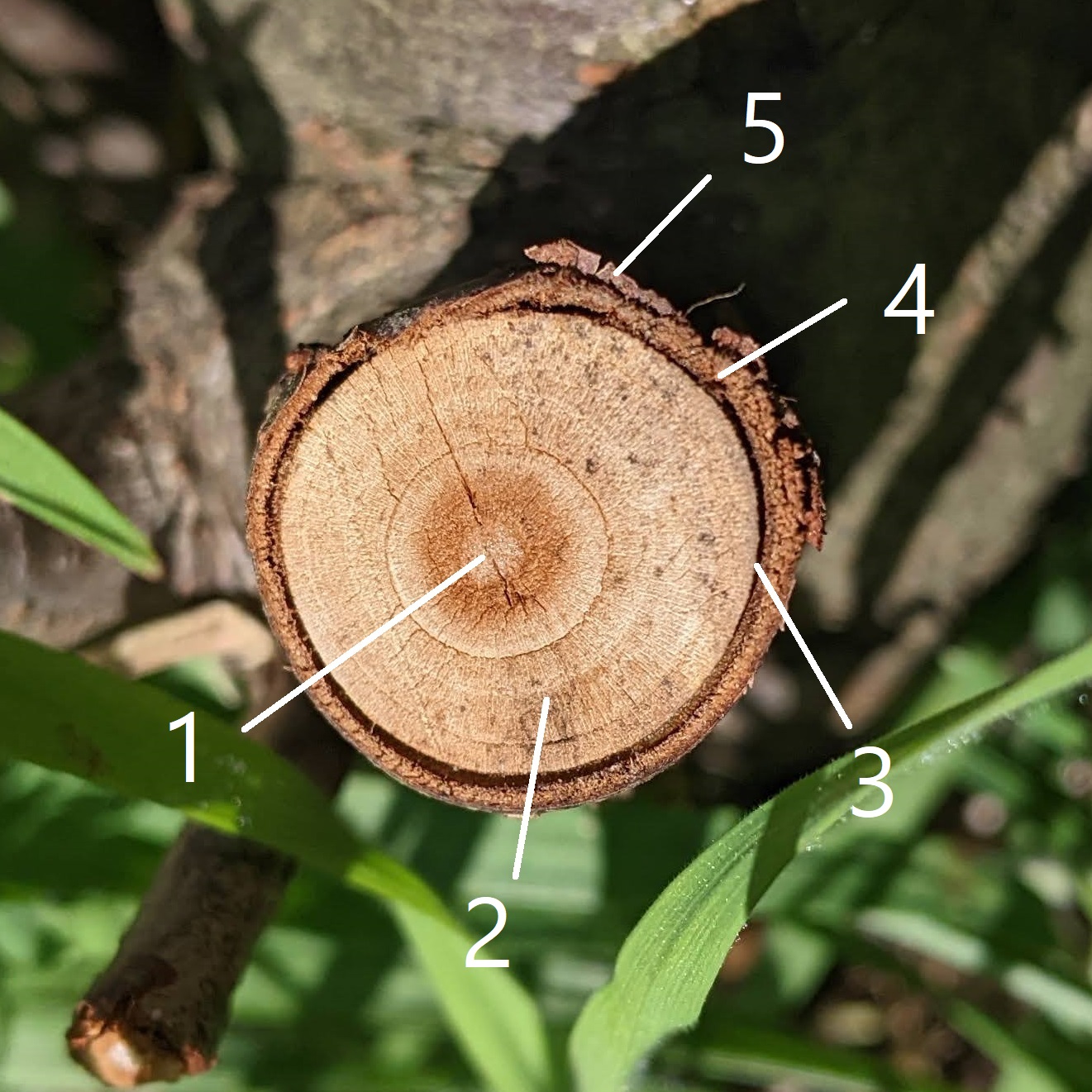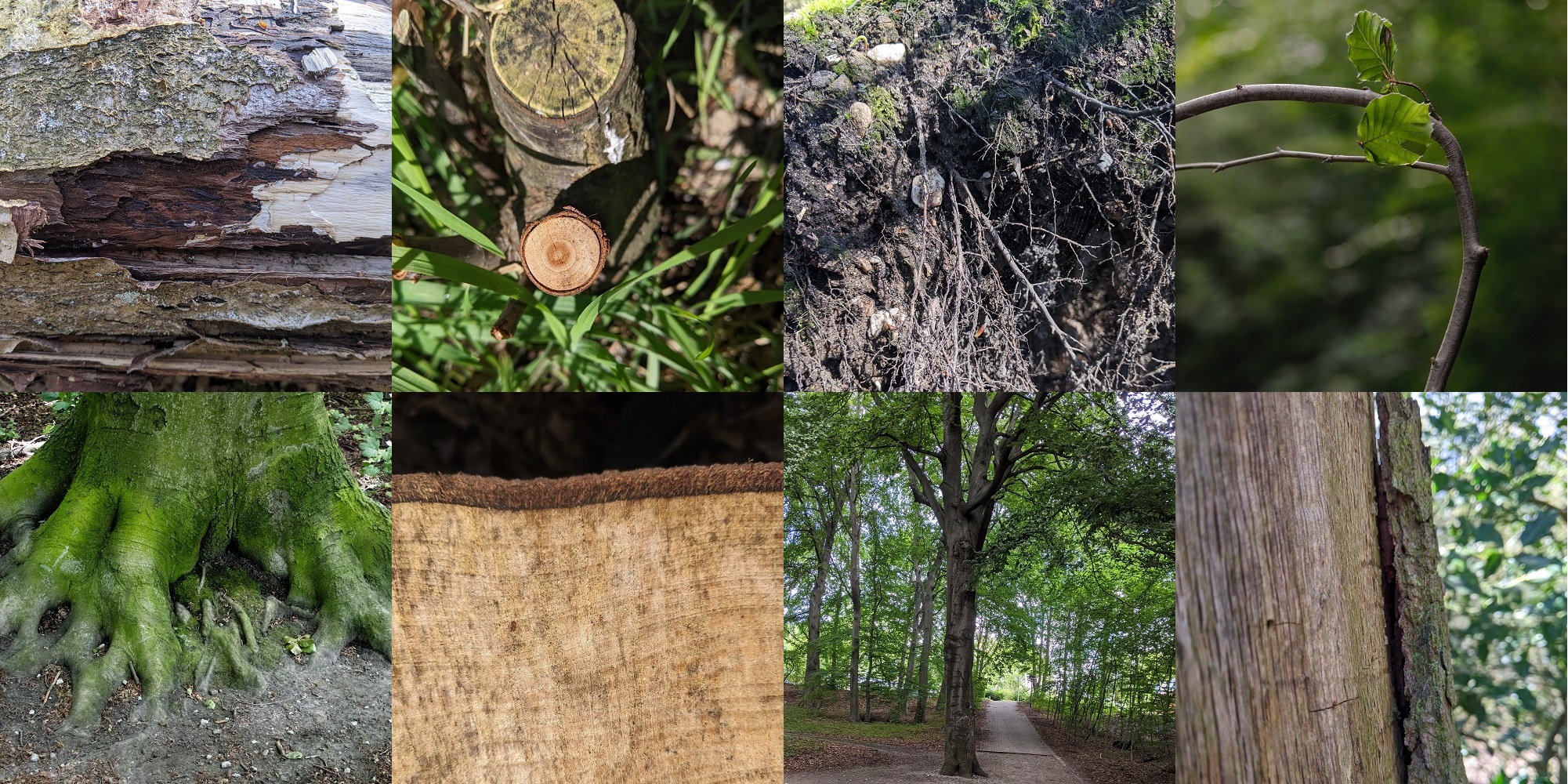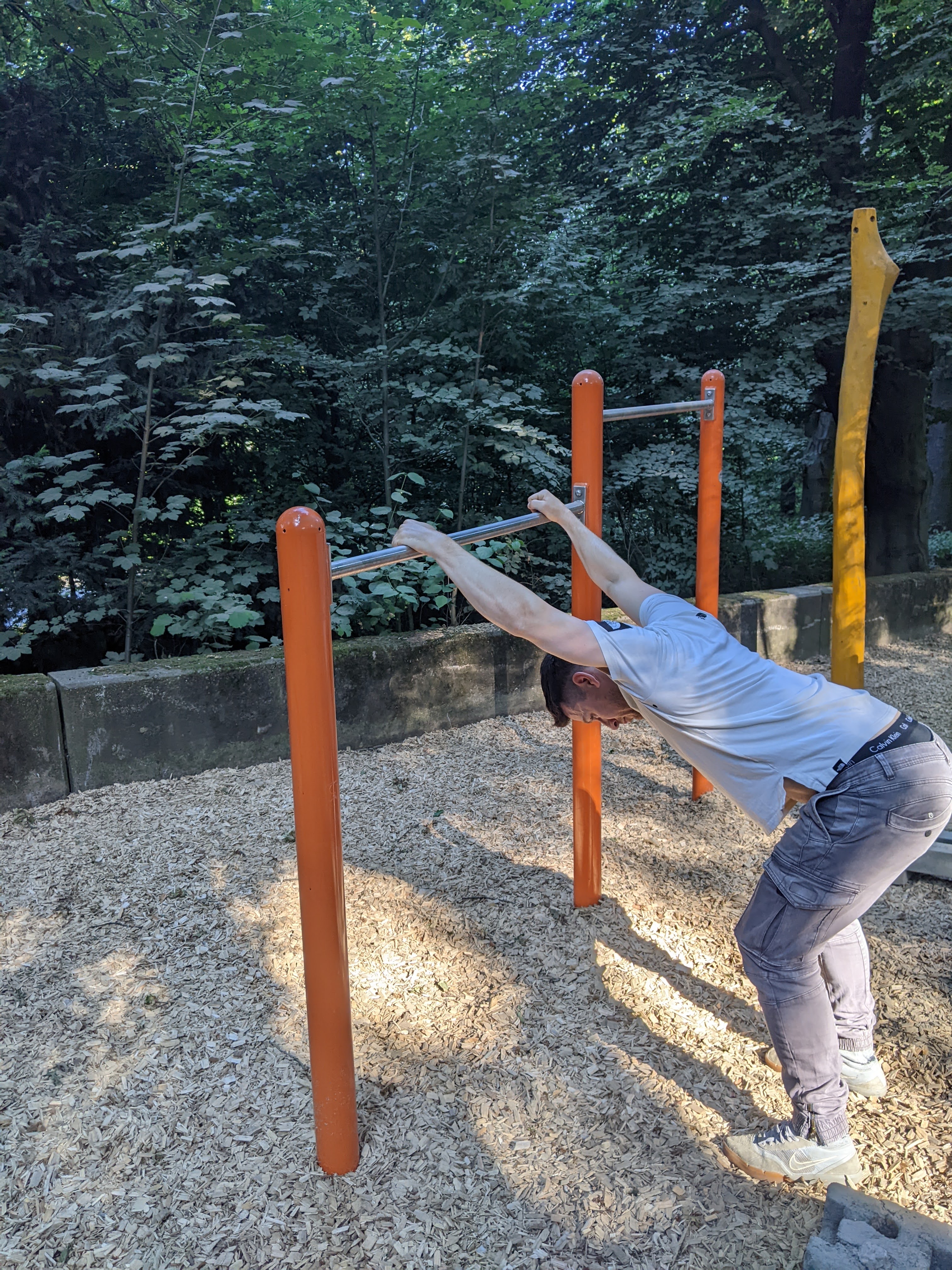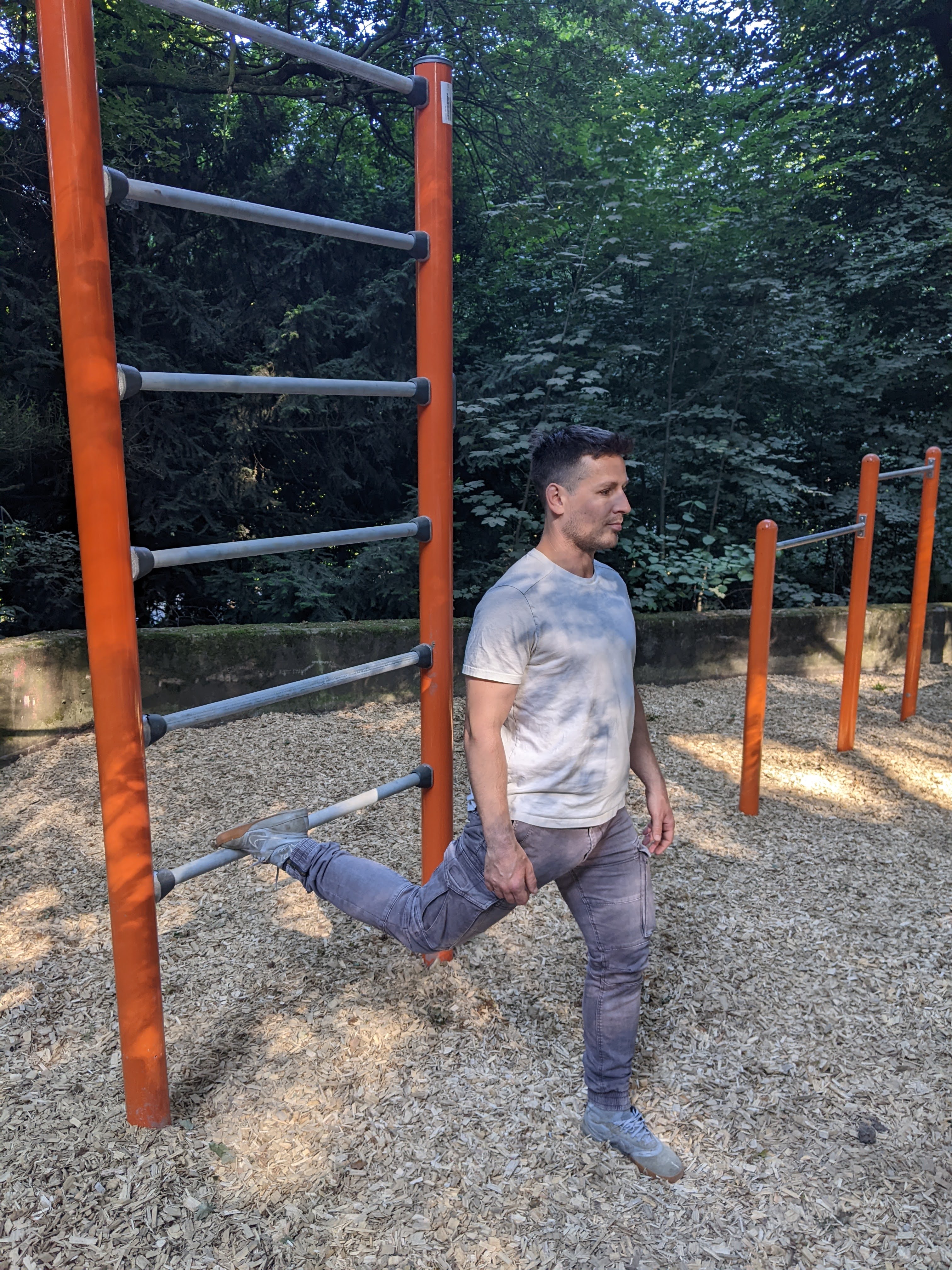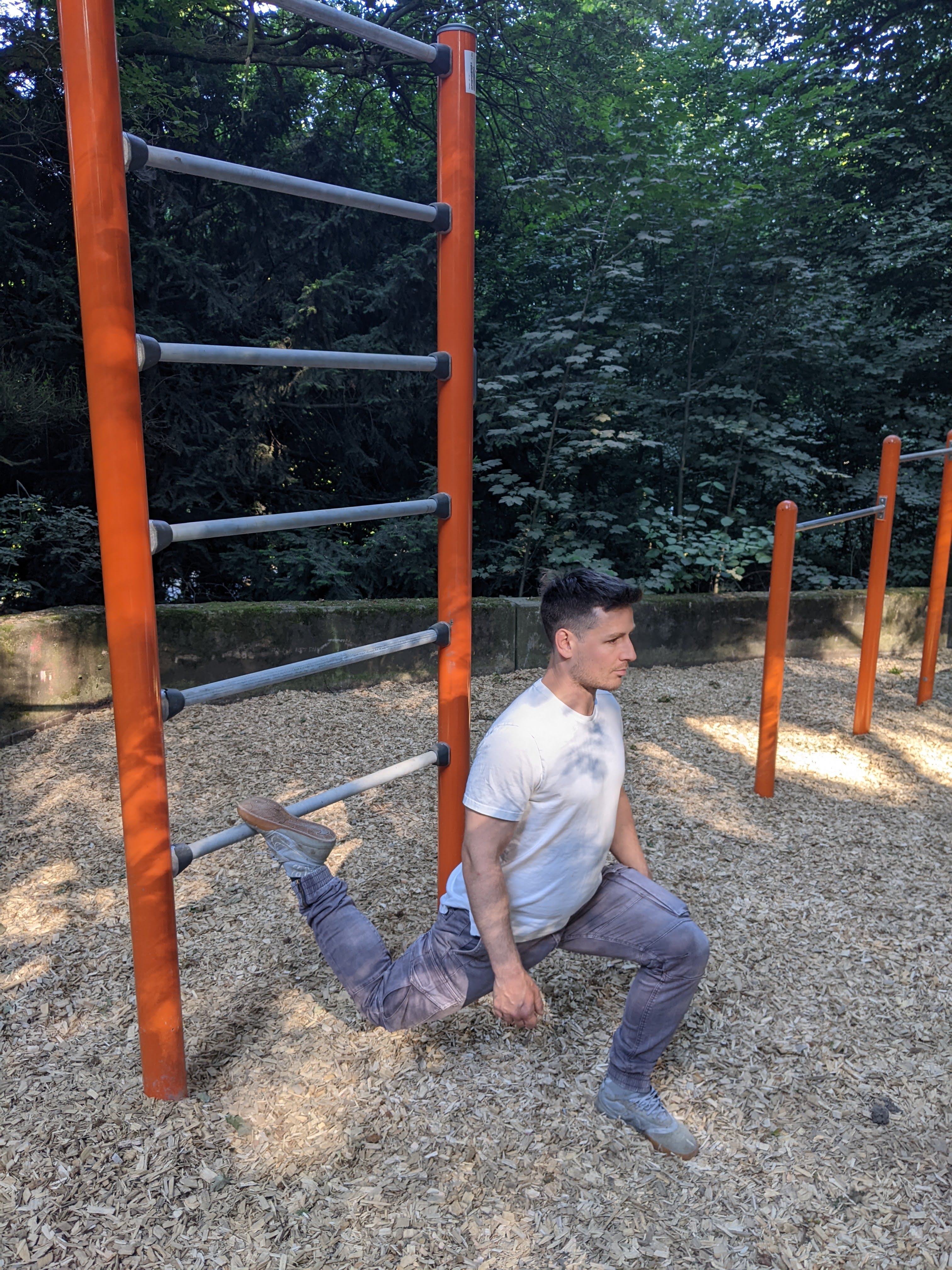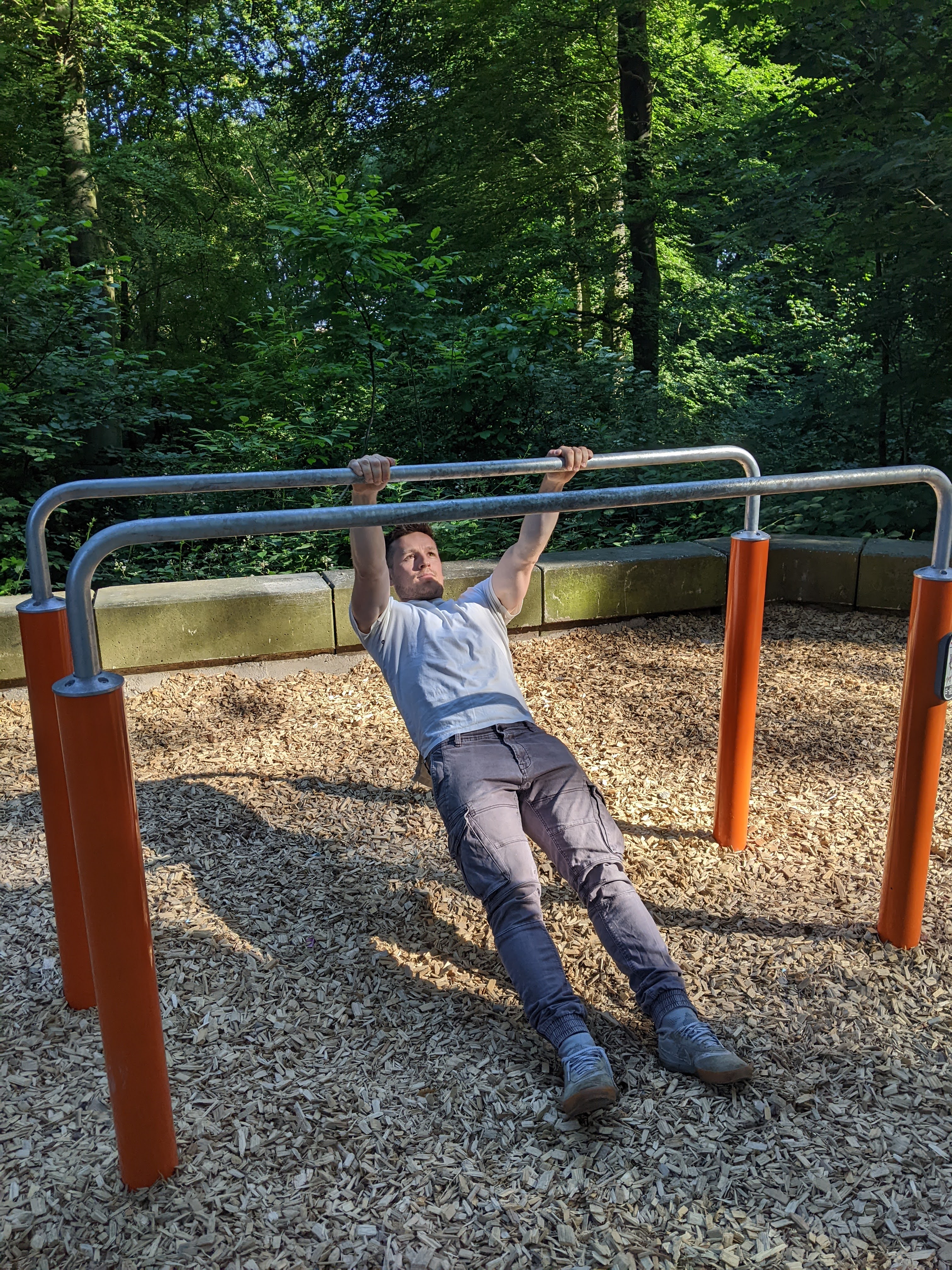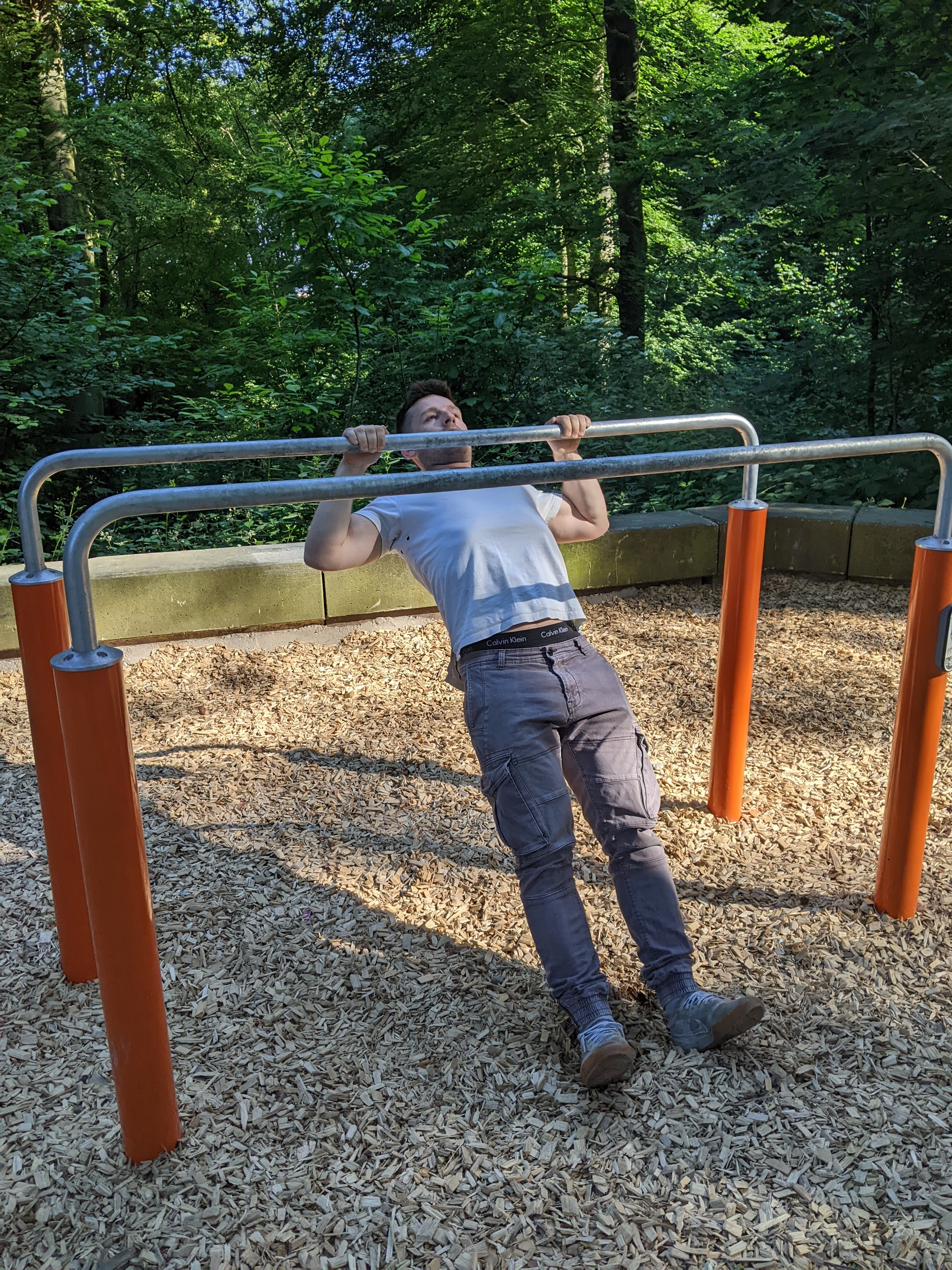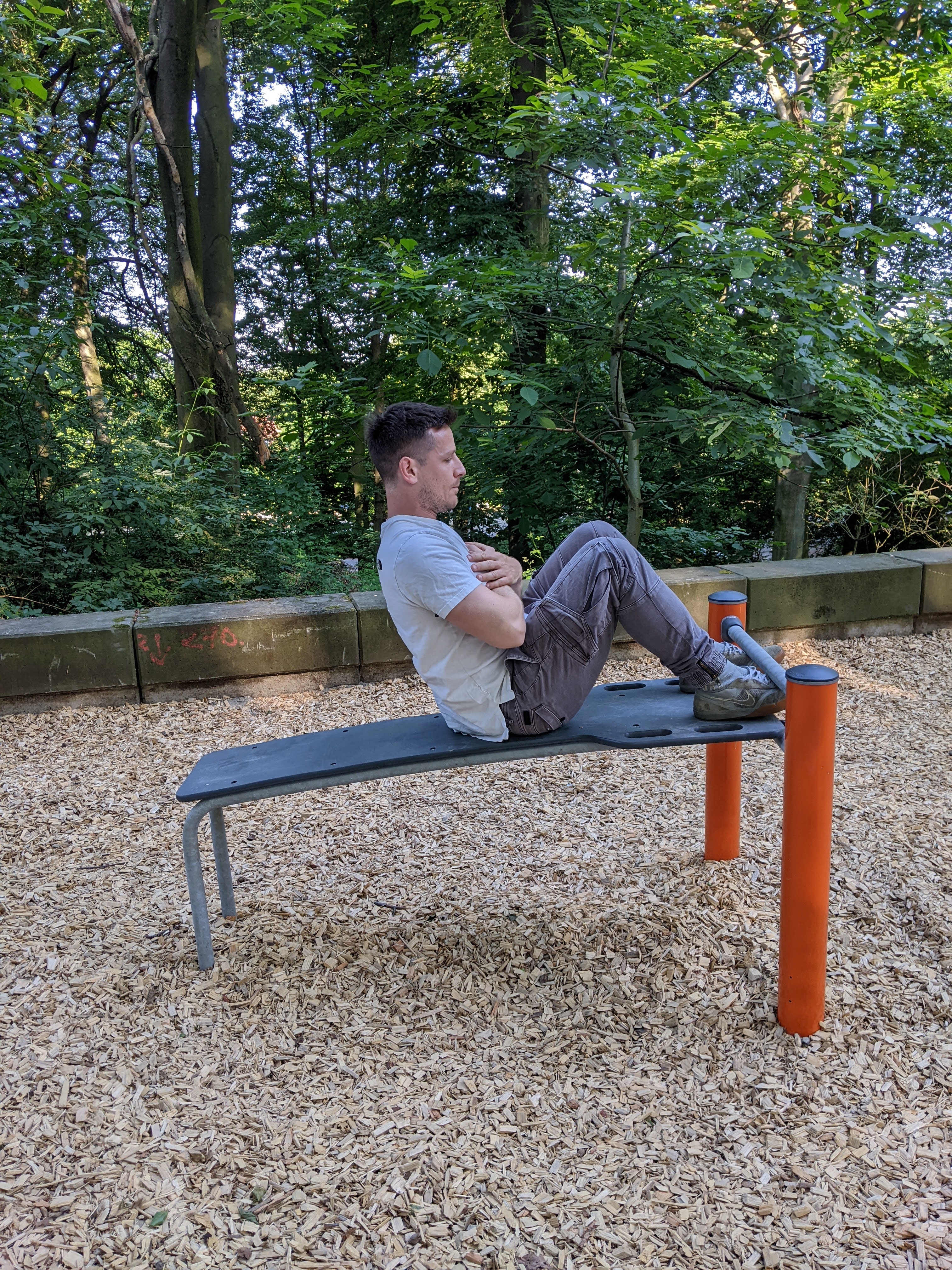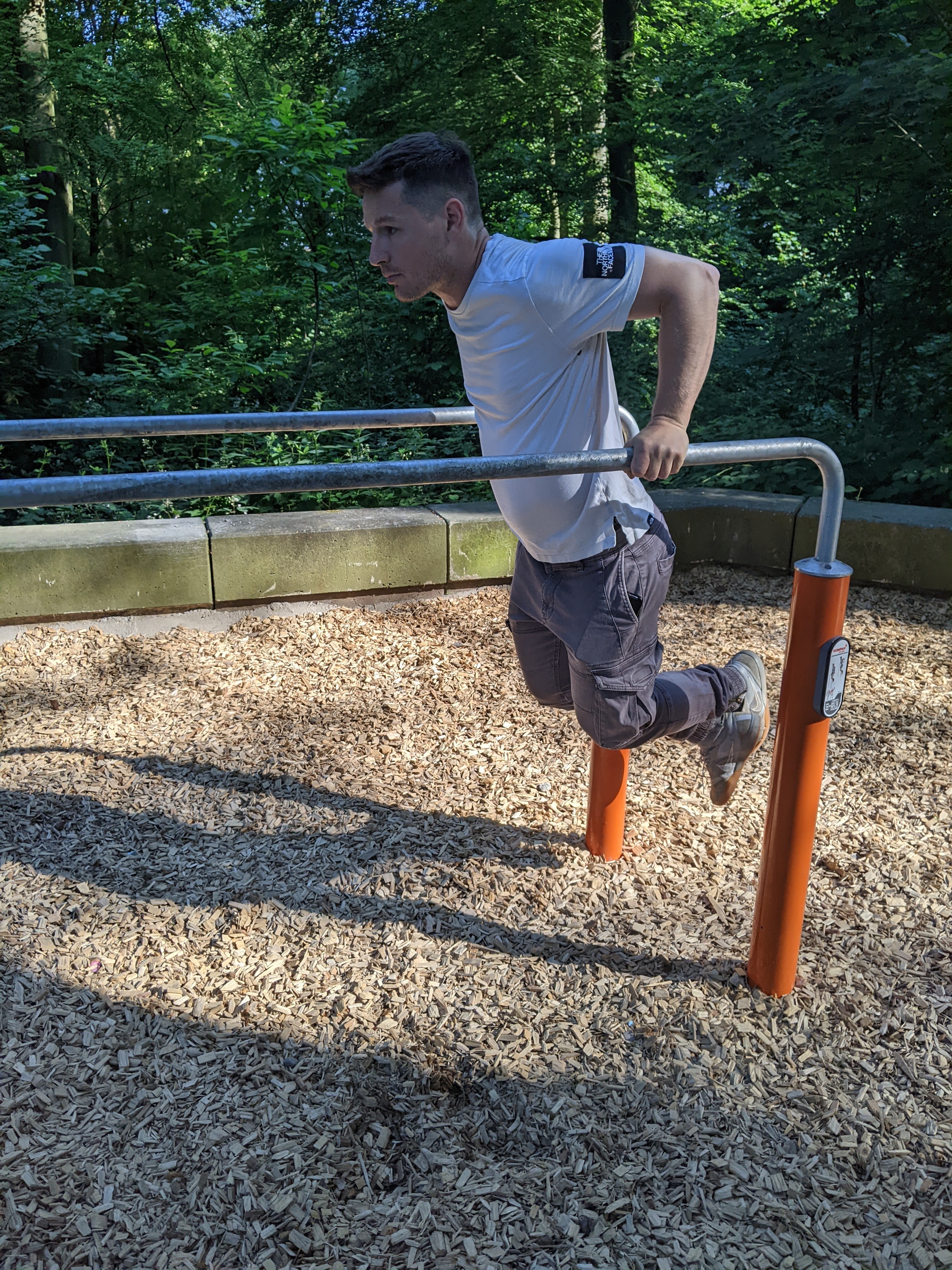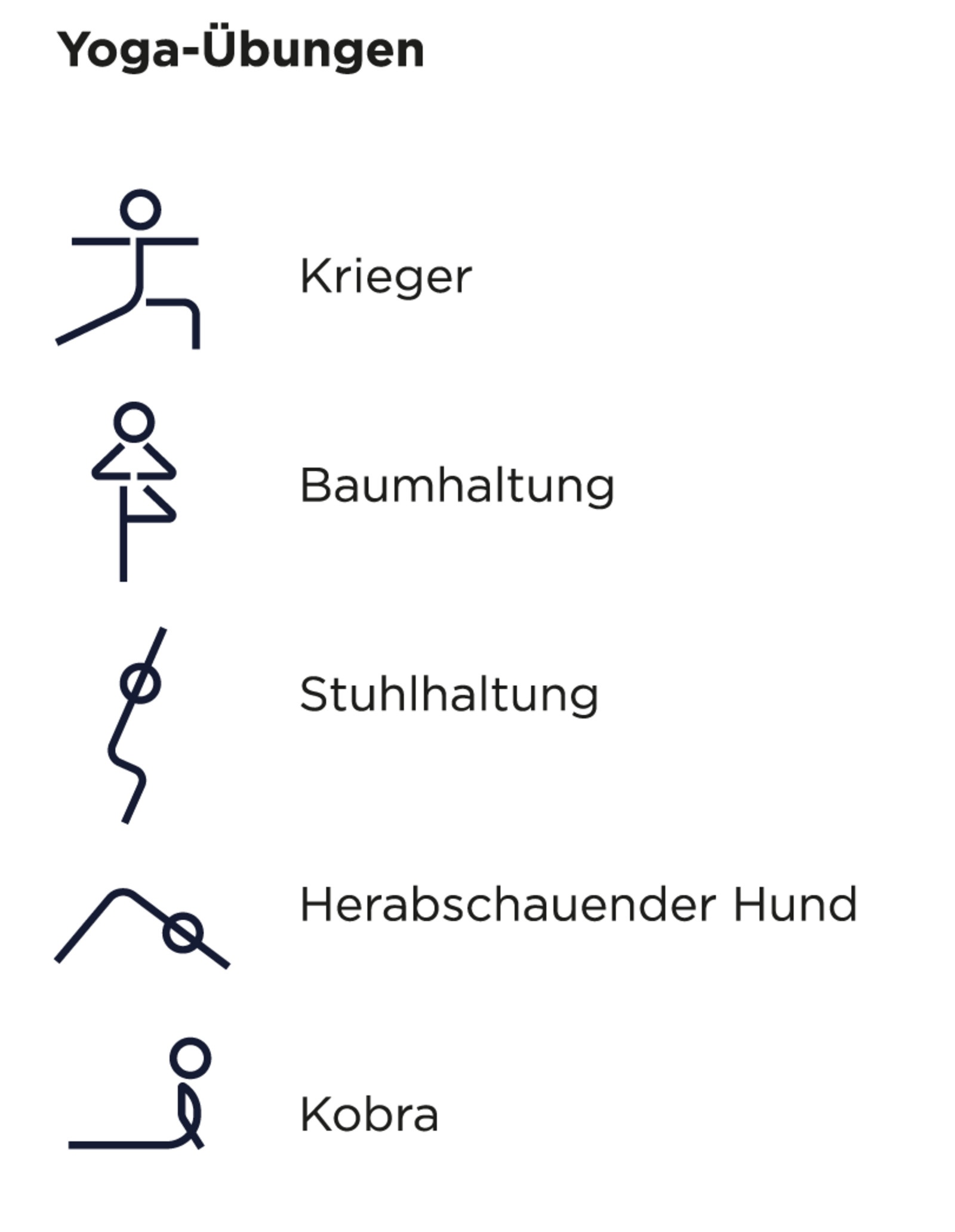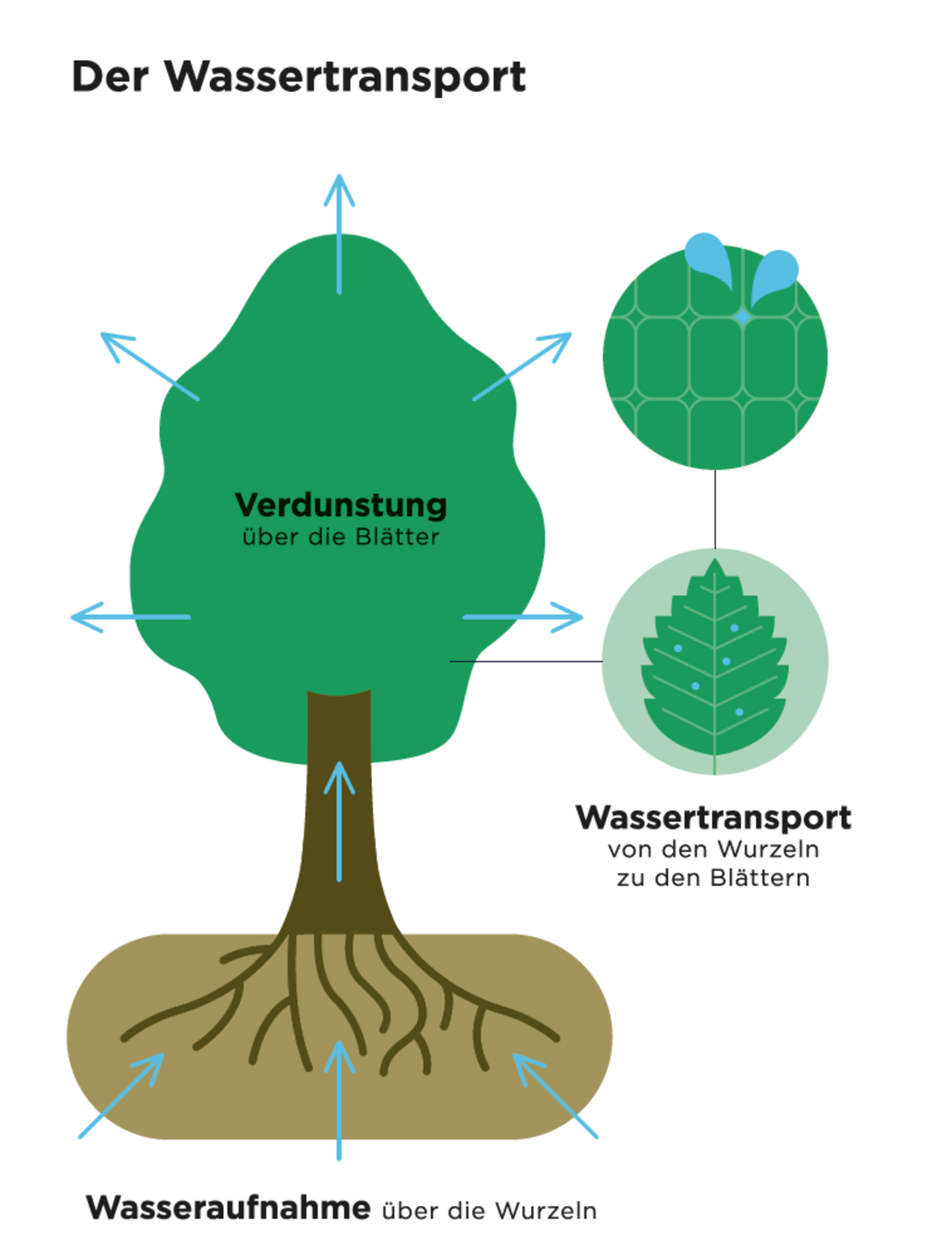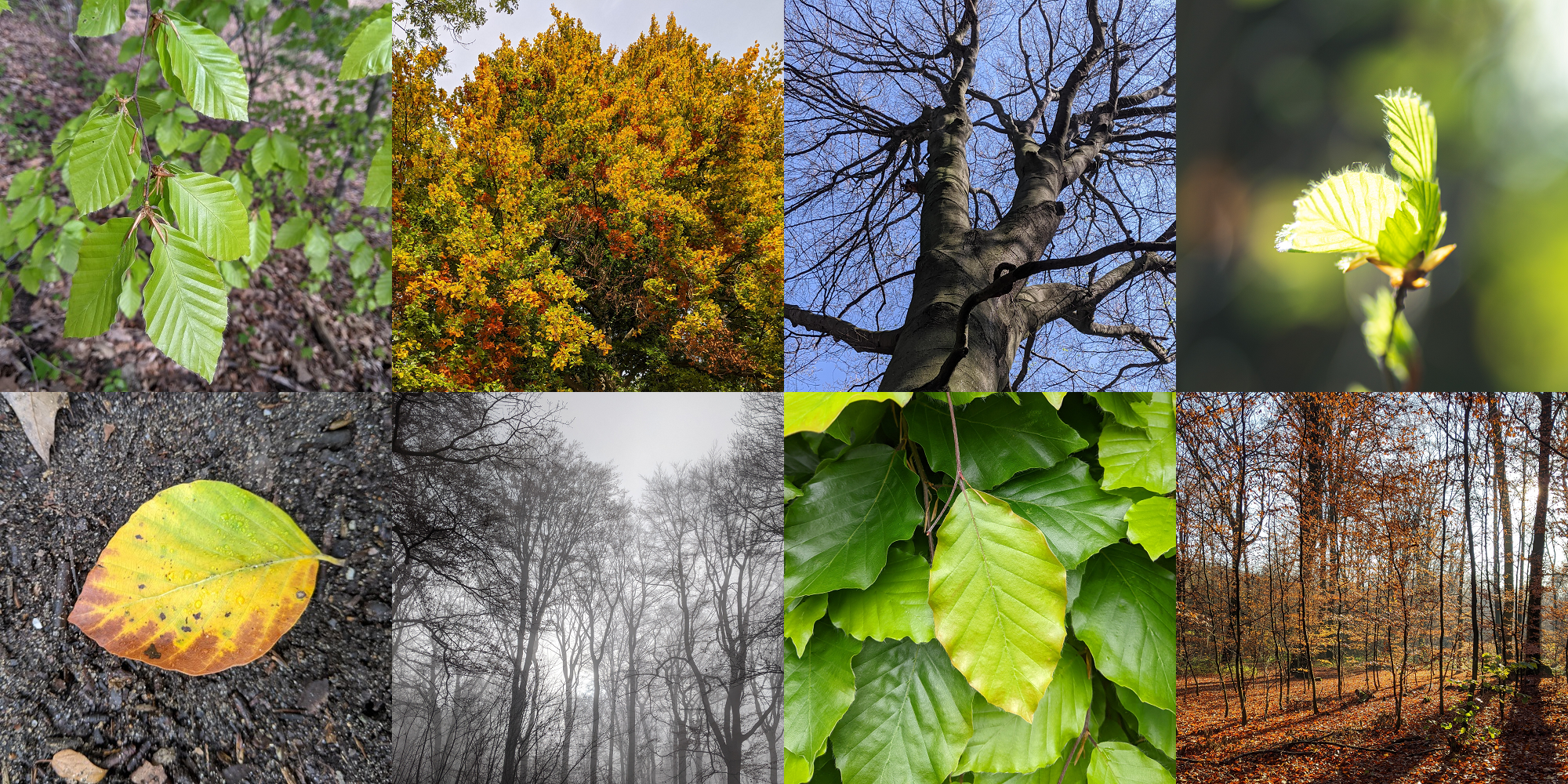Beech Trail Vonderort
VONDERORT IS THE PARK IN MOTION
The Revierpark Vonderort has become a park in motion. The new park motto fits perfectly as there are plenty of opportunities for physical activity in the park. You can go for a leisurely stroll, jog, or engage in Nordic walking along the park's pathways. Boule areas, ping-pong tables, and even chess tables are available for your enjoyment. The activity hill offers opportunities for bike racing on the pump track, as well as playing soccer or basketball with your friends. In the “Trend & Fun Sports Arena”, you can have a blast bouncing on the trampoline and testing your climbing skills on the boulder rocks. And let's not forget about the beech trail!
In the “Nature and Movement Beech Trail”, the forest comes alive with motion. The 10 stations will guide you through Revierpark Vonderort, offering a wide range of activities and opportunities for movement. Whether you're looking to get a great workout, explore the park, or learn about the forest and its most prevalent tree species in Vonderort, this trail has it all.
Station 1: Beech walk
The forest is in motion! Discover the secrets of the beech forest on Revierpark Vonderort`s beech trail. Discover the forest through ten interactive stations along our nature trail and get yourself active at each station! The Copper Beech has a long life. At this first station, look for the right order of its life cycle, from beechnut to adult tree. The beech walk leads you up and down the winding path along seven milestones in the life of the copper beech.
The beech cycle
• There is already a new tree in the beechnut
• After the winter frost, it can germinate
• At the end of March, beech sprouts are everywhere
• In the middle of the year, more and more leaves sprout
• The beech grows about half a metre every year
• At the age of 40 it begins to produce beechnuts
• Between September and October the beechnuts are ripe
Further information
Forest, forest, beech forest …
The Revierpark Vonderort is predominantly covered by forest, with trees stretching in every direction, creating a symphony of rustling leaves and chirping birds. Have you noticed the remarkable similarity among the trees in Vonderort? The most abundant tree species in the park is the copper beech, often simply referred to as beech. Its distinctive reddish wood gives it the name "copper beech." As a result, we have a magnificent beech forest right here in Vonderort.
The beech is not only the most common deciduous tree in Germany, but can also be found almost everywhere. So, what makes the red beech so widespread? There are several reasons for this. Firstly, the beech is well-suited to the mild and humid climate of Central Europe. While other trees can also thrive in such conditions, the beech stands out due to its impressive size and longevity. Additionally, the beech has a remarkable tolerance for shade, which is not commonly seen in other tree species. In the upcoming stations, we will delve deeper into these aspects of the beech tree.
The life of the chopper beech
The life of a copper beech begins in a small form as a beechnut. During autumn, these nuts rest on the forest floor, awaiting their transformation into towering trees. However, germinating during the autumn season wouldn't be advantageous as the delicate first leaves would succumb to the harsh winter frost. Hence, the beechnut possesses a clever mechanism. It can only begin to germinate after it has undergone the necessary period of frost.
In spring, when the temperatures begin to rise, the first leaflets push out. These leaflets have a distinct appearance, differing from the typical beech leaves. These cotyledons are firm, semi-rounded, and of a dark green colour. At the end of April, the whole floor in the beech forest is adorned with numerous small beech seedlings. During the first year, these seedlings develop an increasing number of leaves, displaying the characteristic thin, delicate, and light green foliage of the beech. Gradually, the seedlings grow into young beech trees, and from the age of 40 to 60 years, the beech tree itself produces beechnuts for the first time in its life. And thus, the cycle of the beech’s life begins anew.
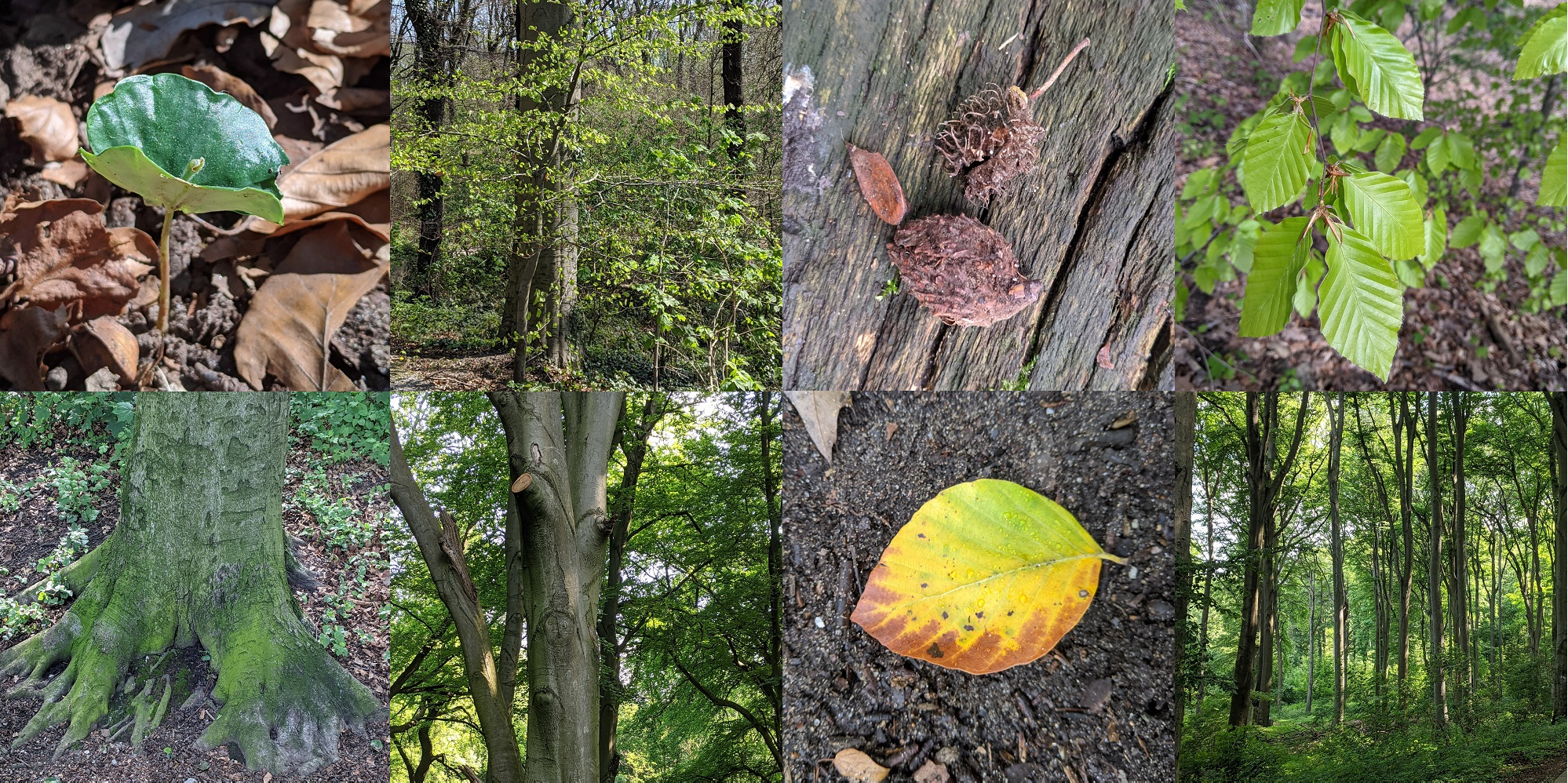
This is how you recognise the copper beech in any season of the year:
Common Name: Copper beech
Scientific Name: Fagus sylvatica
Age: Typically 150 years, but can live up to 300 years
Size: Ranging from 25 to 40 meters in height
Trunk: Smooth and silvery grey bark
Leaves: Ovate-shaped and light green, measuring approximately 7 cm in length
Flowers: Inconspicuous light green blooms
Fruit: triangular nuts known as beechnuts
weiße Schachtel
Station 2: Forest edge steps
At the forest edge, an open meadow gradually turns into a forest. However, the forest edge is a very special habitat where diverse animal and plant species come together. As you move from the sunny meadow towards the forest, you will encounter three distinct stages of transition.
The first stage is the herbaceous margin, where herbs bloom, wild bees hum, and butterflies flutter. In the second stage, known as the shrub belt, numerous shrubs thrive, offering flowers and fruits that serve as food for insects and birds. Deeper into the forest, amidst the dense branches, hedgehogs find their cozy homes. The third stage is characterised by the forest mantle, consisting of smaller or young trees and tall shrubs. Since ample sunlight still reaches this area, tree species that thrive in sunny conditions flourish here. However, you won't find our copper beech in this particular section; it prefers the shaded areas further within the forest. As you reach the second station of the beech trail, take advantage of the steps along the forest edge to maintain balance and stretch.
Further information
Stepped forest edge, a real protective shield.
The three stages of a healthy forest edge are the herbaceous margin, the shrub belt, and the forest mantle. Together, these stages can span several meters in width. They are not always perfectly aligned in a straight row; instead, they often overlap, creating a mosaic of different edge tiers.
The stepped forest edge serves as a protective shield for the forest behind it. Its dense structure helps to block the direct impact of wind on the forest. This wind protection offers several advantages: it helps to retain moisture within the forest and creates a climate that is generally slightly warmer than the surrounding area. These unique conditions are crucial for numerous plants and animals within the forest. Without a stepped forest edge, the wind can easily pass through the trees, carrying away moisture and heat. However, with a stepped forest edge, the forest is shielded from the wind. This protection becomes particularly significant during powerful winds or storms, as the stepped forest edge helps prevent trees from toppling over.
Animals in the forest edge
A stepped forest edge is a truly unique habitat, serving as a transition between sunny meadows and shady forests. This diverse environment accommodates species that thrive in sunnier conditions, as well as those that prefer the shade. Here, you can discover blooming herbs like comfrey or woodruff. Shrubs such as roses, blackberries, and black elder also flourish in this zone. Sun-loving trees like mountain ash or early bird cherry can be found within the forest mantle, while ferns and mosses occasionally conceal themselves amidst the undergrowth. The forest edge hosts a wide variety of plants, providing shelter, resting spots, and food for numerous animals. Take the blackberry, for instance, with its pink blossoms in spring that attract bees and butterflies. Later in summer and autumn, the bush bears dark blackberry fruits that are eagerly consumed by birds. Moreover, the blackberry bush's dense branches, adorned with thorny bristles, offer protection for mice or bird nests, creating a safe place within its prickly embrace.
The meadow and forest floor, being relatively open, provide limited hiding spots for animals. Therefore, the stepped forest edge plays a crucial role by offering diverse hiding places. The sunny herbaceous margin and blooming shrub belt are teeming with a wide variety of wild bees, grasshoppers, and beetles, creating a buzz of activity. Numerous butterflies, including the Comma butterfly and the Yellow Brimstone butterfly, flutter around this area. On the ground, one can spot amphibians such as slow worms and even wall lizards. The common toad is also frequently found in this habitat.
Of course, the stepped forest edge is alive with the sounds of chirping birds among the trees and shrubs. It is a haven for many bird species. The European goldfinch can be spotted with its colourful plumage, while the knocking of a woodpecker on a tree trunk resonates through the air and the blackbird enjoys blackberries as a tasty snack. As the evening falls, the hedgehogs and bats emerge from their hiding places, and the fox, too, finds comfort in the stepped forest edge.

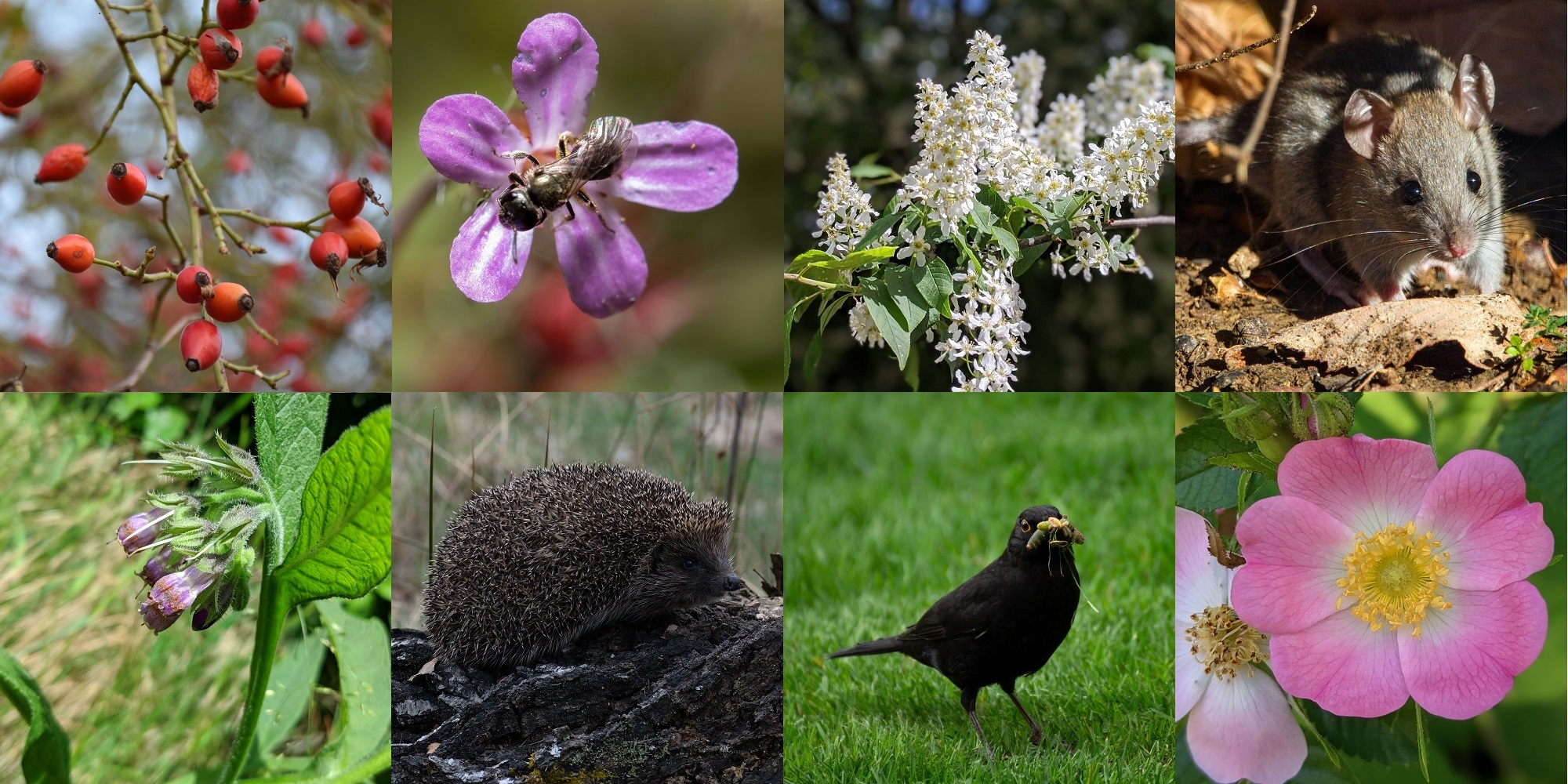
The forest edge is in danger.
Unfortunately, genuine forest edges with three distinct steps have become increasingly rare. Forests often abruptly end at fields, settlements, or roads. As a result, the wind can freely enter, altering the habitat for plants and animals. The diminishing space available for forest edges is primarily due to the expansion of roads, buildings, and cultivated fields. A healthy forest edge requires a diverse range of shrubs and trees of varying ages. Alongside young trees, the presence of old or even dead trees is crucial. These decaying trees, known as deadwood, are far from lifeless. They provide nesting spaces for animals and serve as habitats for numerous insects.
More and more forest owners have come to recognise the significance of deadwood and stepped forest edges in maintaining a healthy forest. They are increasingly allowing deadwood to remain on the ground or leaving standing dead trees in place. Moreover, new stepped forest edges are being established in various locations, just like in this park.
Station 3: Searching the beeches
The pond of the Revierpark is a good place to take a break and relax. Look through the window and let your eyes wander over the wooded shore. Take a moment to consciously inhale and exhale. Can you smell the water and the forest? The dense bank, where the forest and water meet directly, is completely dedicated to nature. Can you spot the copper beeches? They are positioned in a second row because it is too humid for them right next to the water. Branches and fallen trees lie in the pond. In the shoreline area, water birds utilise the deadwood to dry themselves and keep a watchful eye. If you're lucky, there's even a kingfisher perched on the branches! Under water, the deadwood is a good hiding place for young fish and amphibians.
Take your time to breathe deeply
The pond of the Revierpark is a perfect spot to stop and take a deep breath. Just relax and become aware of how you're feeling.
Breathing exercises can help you relax and reduce stress. They also assist in clearing the mind and promoting present-moment awareness. Moreover, they enhance concentration and strengthen the lungs.
If you're interested, you can try one of the following breathing exercises:
Exercise 1: Mouth and Nose
• Take a deep breath through your nose.
• Hold your breath for two seconds.
• Exhale through your mouth.
• Hold your breath again for two seconds
• Inhale through your nose and exhale through your mouth.
• Breathe in and out deeply, allowing your belly to rise and fall with each breath.
• Repeat the exercise approximately six times.
Exercise 2: Longer Exhalation
• Exhale for twice as long as you inhale.
• Inhale for three seconds.
• Exhale for six seconds.
• Breathe in and out deeply, allowing your belly to rise and fall with each breath.
• Repeat the exercise approximately six times.
Exercise 3: Alternate Breathing
• Begin by closing your right nostril with your thumb.
• Breathe in deeply through your left nostril.
• Release your right nostril and close your left nostril while exhaling.
• Breathe in and out so deeply, allowing your belly to rise and fall with each breath.
• Repeat the exercise three times, then switch sides.
Not every plant likes the same things
Why can’t you find beech trees right on the banks of ponds and rivers? Just like you, beech trees don’t like having wet roots. You can dry your feet or move to a drier place, but plants can’t do that. Therefore, they need to grow in areas where they can thrive from the beginning. Different plants have different preferences when it comes to their growing conditions. There are plants that thrive in water and are well adapted to it, such as reeds that grow in marshy areas or black alders that grow near the water’s edge. Beech trees, on the other hand, prefer shady environments and soil that is slightly moist rather than wet.
Many plants serve as indicators of the environmental conditions in which they grow, simply by their presence in a particular location. That’s why they are referred to as indicator plants. For example, the presence of beech trees indicates that the soil in that area is only slightly moist. Nettles, on the other hand, indicate the presence of nutrient-rich soil.
Why kingfishers don’t like ice
In German, kingfishers are often called "ice birds," which sounds beautiful, just like the rare birds themselves. They have an ice-blue and turquoise back, complemented by a rust-red breast, and they swiftly glide over the water like arrows. In the Revierpark, you can often spot the kingfisher perched on a branch above the water. From this vantage point, the kingfisher patiently observes its favourite prey: small fish. Once it spots a fish, the kingfisher dives into the water with incredible speed and catches its meal. It then returns to a branch to enjoy its feast. But why is the kingfisher, which resembles a blue ice crystal, not actually fond of ice?
For us humans, ice often signifies activities like ice skating, snow-covered paths, and cozy winter gear. However, for the kingfisher, a frozen lake is a significant challenge. It means that no fish can be seen or caught through the thick sheet of ice. Since kingfishers rely on aquatic animals such as fish, tadpoles, or aquatic insects for their diet, they are left without a source of food when the water freezes over. Therefore, every winter, a kingfisher hopes that at least a portion of the pond remains unfrozen.
Station 4: Experience the underground
You stand in the middle of the old beech forest between thick trunks, under the wide treetops. Everywhere on and under the 100-year-old copper beeches, plants and animals exist in an uninterrupted cycle. A beech leaf falls from the tree. Within a matter of weeks and with the help of active decomposers like woodlice and mushrooms, it undergoes a transformative process, turning into nutrient-rich forest soil. Beechnuts and other seeds germinate on the soil. Over time, they grow into new trees or shrubs, also losing their leaves and branches. And so it all begins anew. Here, you can feel and discover the living forest floor. Walk barefoot and feel the ground. Maybe let someone guide you with your eyes closed, to sense even more differences. This also trains your movements and your balance.
Further information
Secret soil life
With so many trees in the forest, a lot of leaves fall onto the forest floor during autumn. However, you may wonder why the forest isn't already overwhelmed with leaves. The answer lies in the incredible world of soil organisms. These organisms come in various sizes, ranging from small to minuscule. A handful of forest soil harbours nearly as many living beings as there are people on Earth. This fact may seem unbelievable, but it is indeed true.
Visible to the naked eye, worms, isopods, beetles, and centipedes play a vital role in the transformation of tree leaves into fresh soil. However, countless other organisms, which are more challenging to observe, are also hard at work in the leaf decomposition process. Springtails, mites, bacteria, and fungi also contribute their efforts to ensure the continuous formation of new soil in the forest. They even have the ability to break down entire trees and decompose deceased animals. It takes several months for a beech leaf to decompose. But what about garbage in the forest? Can it decompose as well?
It depends on the type of garbage. For instance, a paper handkerchief lying in the forest may takes around six months to decompose. This is possible because paper is derived from wood and can be broken down by microorganisms, the small living creatures in the soil. However, materials like glass or plastic cannot be decomposed by living organisms and only degrade very slowly over time due to weather conditions such as rain, wind, and movement. A plastic bag can take up to 500 years to decompose, leaving behind micro-plastic particles in the soil.
It's truly remarkable what soil organisms are capable of. Nevertheless, it is our responsibility to assist them by only leaving behind what naturally belongs in the forest.
Try our experiment: Water storage
Different types of soils have varying water-holding capacities. To conduct an experiment and determine which soil type stores the most water, you can follow these steps with the assistance of adults:
Materials:
• Two empty PET water bottles (solid plastic bottles)
• Cutter knife and scissors
• Two large empty jam jars without lids
• Two empty cups
• Different soil types
• Water
Experimental setup:
• With the help of an adult, use a cutter knife and scissors to cut off the bottom of two PET plastic bottles, as shown in the picture.
• Make three small holes in the lids of the bottles, using a cutter knife or a small chestnut borer.
• Place the lids back onto the bottles and position the bottles upside down on top of empty jam jars.
• Fill each bottle with different types of soil. You can use forest soil, soil from your garden, or gravelly soil.
• Ensure that you add approximately the same amount of soil to each bottle, filling them to about half capacity.
Execution:
• Fill two cups with equal amounts of water (approximately 200 ml).
• Fill the bottles with the same amount of water and add the same amount of gravel to each bottle.
• Observe what happens. Which bottom allows the water to flow through more quickly?
• Feel free to exchange the bottoms after the experiment and test different types of soil again.
Stop! Do not read on until you have tried it!
Soils with coarse stones cannot store water well; the water simply flows through. As a result, during warm weather, the upper layers of soil have limited water availability, causing the soil and its surroundings to become very warm. In gravel gardens, for instance, water quickly drains through the large gaps between the stones.
Forest soil, which contains a high amount of decomposed organic matter, has better water retention capacity. The water gets trapped in small gaps and does not drain as rapidly. When water seeps slowly, plants can easily access it. Furthermore, the slow evaporation of water helps to cool the environment, as seen in forests or green gardens.
Soil is a super talent
Soil is highly diverse and has many important functions. It can consist of decomposed organic material or contain a higher proportion of stones. It is present all around the world and serves as the foundation of life. Without soil, we would not be able to grow food, and it also serves as a habitat for countless animals and plants. However, did you know that soil also plays a role in providing clean water? When it rains, the water infiltrates the soil and undergoes a cleaning process. Over time, as more water accumulates in the soil, it rises through springs, eventually forming streams, rivers, and lakes. Therefore, soil has the capacity to store water, which is crucial for maintaining our climate balance and keeping us cool during hot days. Furthermore, soil has the ability to store not only water but also carbon dioxide (CO2) gas.
Station 5: Strong and elastic
Copper beeches can grow up to 45 meters tall and live for over 300 years. Each year, a copper beech grows approximately 50 cm in height and one cm in width. Throughout its lifespan, the tree must endure various weather conditions and withstand the forces of wind. It achieves this by maintaining stability and flexibility. Take a look around. Can you spot both young and old copper beech trees? Now, test your own flexibility and stability. Strengthen your coordination and muscles by climbing and balancing. By doing so, you can maintain the same level of stability and agility as these trees.
Further information
In a beech forest, the large beech trees are spaced far enough apart to ensure they have sufficient space and access to light. Among the tall, straight trunks, it is common to find young beech trees standing close together. Many of these trees are around two meters in height and are still in their teenage phase. The growth of these young beeches comes to a halt at this stage. However, when a large tree falls and exposes the small beeches to sudden light, they immediately resume their growth. This serves as a signal to start a race, where the fastest-growing beech tree emerges as the winner, filling the gap created by the fallen tree. The waiting beeches are able to adapt to the limited light during this period as they are shade-tolerant. This phenomenon of waiting is referred to as the "Oskar syndrome," named after the character Oskar in Günter Grass's book "The Tin Drum," who decides not to grow any further at the age of three.
Wood - what is it actually?
Wood, a marvel of nature, is known for its stability and resistance, and it's no wonder that it is the most widely used plant product in the world. Wood is composed of two different components: cellulose, a long fibrous material, and lignin, a glue-like substance that binds the cellulose together. Lignin provides additional strength to the wood, making it highly stable.
A tree is composed of multiple layers. The innermost layer is called the heartwood (1), which provides stability to the tree. Surrounding the heartwood is the sapwood (2), where nutrients are stored and water is transported from the roots to the tree's canopy. The cambium layer (3) ensures the continuous growth of the tree by generating new wood. Another layer, known as the bast (4), is responsible for the transportation of nutrients and sugars. Lastly, there is the protective layer known as the bark (5), which covers the trunk of the tree. The bark shields the tree from temperature variations and protects it from animals.
Ring by ring, one year older
From the inside out, the wood within a tree becomes progressively younger. The cambium layer (3) located in the trunk generates new wood each year, layer by layer. But why do we see annual rings? The reason lies in the tree's need to absorb a substantial amount of water during spring in order to rapidly grow numerous leaves. To facilitate this, the wood needs to have large wood particles with gaps through which water can flow. The size of the wood particle determines the size of the gap, allowing for a greater volume of water to pass through. Consequently, during spring, very large wood particles form, that enable a significant flow of water. These particles appear lighter in color and contribute to the formation of the light ring. In summer and autumn, the tree's growth slows down, resulting in the development of smaller wood cells. These smaller cells are closer together, giving the wood a darker appearance. The dark rings are formed.
Station 6: Trail and climb
The forest never stands still, it is always in motion! The wind constantly blows through branches and leaves. Animals climb up and down the treetops, scurrying across the smooth forest floor between the shrubs. Birds land in the treetops. Here in Vonderort there are even lianas like in the jungle. Ivy or clematis climb up and grow almost two meters a year on their way toward the sunlight. Swing yourself from rung to rung like an ivy vine. This way, you strengthen your muscles and get into the rhythm.
Further information
Trees and light
Trees need light to grow, but how do they capture light? Despite lacking eyes, they still grow towards light. When sunlight reaches the plant, neurotransmitters are released, causing the shaded side of the plant to grow faster. This allows the plant to stretch towards the sun. Interestingly, plants can even perceive different colours of light. They also react to different colours. They exhibit faster vertical growth in the presence of red or orange light, while blue light stimulates branching and lateral growth. Green light has a minimal effect on plant growth. Additionally, trees have an innate ability to sense gravity, enabling them to orient themselves vertically. That's why trees always strive to grow upwards, even on inclined mountainsides.
Lianas, even in our forest
We are familiar with images of monkeys moving from one liana to another in the jungle. Interestingly, we also have lianas in our own forests and animals who swing on them. Squirrels and various bird species use lianas to climb or perch. Lianas are climbing plants that start their growth from the ground and then ascend by using other plants or structures for support. Since they lack a sturdy trunk, they are unable to stand independently. Instead, they rely on tree trunks to climb higher and reach towards the light.
In the Revierpark forest, you can observe the presence of ivy and clematis as they twine their way through the forest.
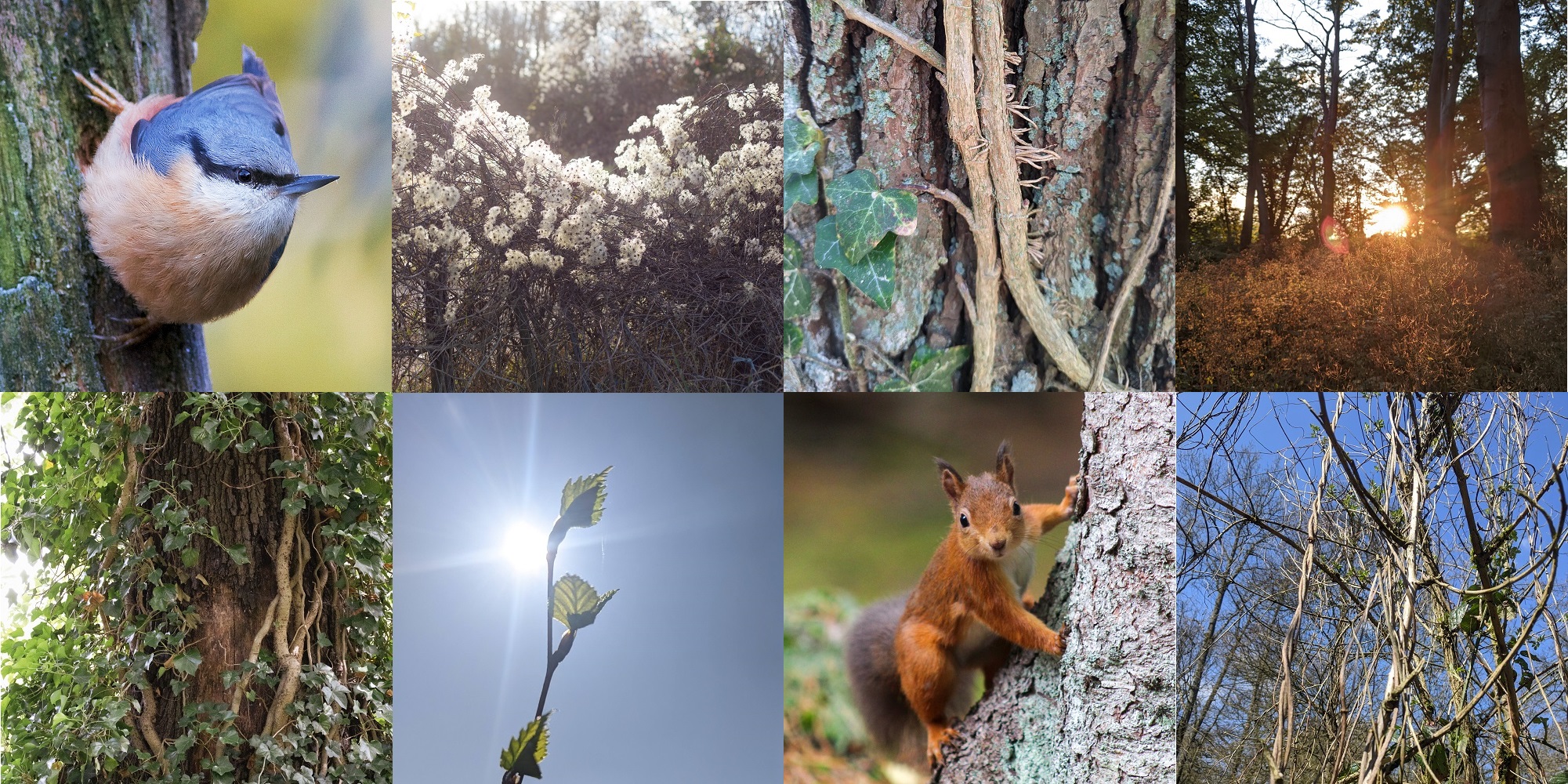
Station 7: Tree body
Trees are built on a simple and perfect plan: Deep within the ground lie their roots, while at the top stands their solid trunk with branches, twigs, and thousands of leaves. Trees can grow very old because they are able to withstand the wind and varying weather conditions, including extreme temperatures. Like humans, trees need water, minerals, and energy to grow. The remarkable aspect is, that trees use solar energy to accomplish this. A 100-year-old beech tree converts water, carbon dioxide (CO2) from the air and sunlight into approximately 12 kg of sugar every day. The sugar is used as an energy store and for wood production. Furthermore, trees also produce 13 kg of oxygen, which is essential for our breathing. So take a deep breath and do some exercises on the bars and sports equipment to boost your fitness.
Further information
From light to wood
Plants can perform a remarkable feat: they can harness energy from light. They rely on their green leaves to accomplish this. When light strikes the green pigment in the leaves, a series of steps takes place that results in the production of sugar. This process is known as photosynthesis. The term "photo" refers to light, and "synthesis" refers to the creation of something. Hence, the name encapsulates the essence of the process: using light to generate sugar. Sugar serves as an excellent energy reservoir. Through the abundant sugar, cellulose is produced. With an ample supply of cellulose, the tree can experience rapid growth and progressively increase in size.
By the way, as a "byproduct," oxygen is released during the conversion of light into sugar. A 150-year-old beech tree produces 11,000 litres of oxygen per day. This amount of oxygen can sustain the breathing needs of 26 people for one day. It is thanks to plants that living beings, including humans, can live on Earth. Without them, we would have no oxygen to breathe.
Here you can find instructions on how to use the sports equipment for your exercises.
Bulgarian Splits Squads:
In this exercise, the squat is performed with a slightly elevated foot to strengthen your lower body muscles while minimising strain on your back. Here is how you can do the exercise:
• Stand with your back in front of the ladder.
• Place your right foot backward on the ladder while your left foot remains next to it on the floor.
• Keep your body straight and aligned.
• Lower your left leg a little, ensuring that your knee remains directly above your ankle. Inhale during this movement.
• Now return your leg to the starting position while exhaling. Repeat the exercise several times. Switch sides and repeat the exercise with your right leg.
• Throughout the exercise, you can keep your arms tensed in front of your body to maintain overall body tension.
Leg Raises:
This exercise strengthens your abdominal muscles while challenging your entire body by hanging freely from the pull-up bar. Here's how to do the exercise:
• Stand beneath the pull-up bar and grip it slightly wider than your shoulder-width apart.
• Hang from the bar with your arms fully extended, engaging your entire body to stabilise yourself and prevent swinging.
• Slowly pull your knees toward your chest, initiating the movement form your hips while keeping your back straight.
• Hold the position with your knees raised for a moment, then slowly lower your legs back down.
• If your want to increase the difficulty, extend your legs forward and hold them straight for an extended period before lowering them.
• Repeat your chosen variation for several repetitions. Once you've completed the desired number of repetitions, release your grip from the bar and return to a standing position.
You can do the same here!
Double Shoulder Stretch:
To improve your shoulder mobility, you can stretch your shoulder and chest muscles on the ladder. Follow these instructions to perform the stretch:
• Stand facing the ladder.
• Bend your knees slightly.
• With a straight back, lean your upper body forward and reach out to grasp one of the ladder rungs with both hands.
• Take a deep breath in and as you exhale, allow your head to drop down between your arms. Keep your arms slightly above shoulder level.
• Hold the position for a few breaths, feeling the stretch in the shoulders, then release.
Station 8: Forest body
There are not only trees in the forest. Plants, animals, soil, as well as the weather and the light, are also components of the forest. They are all part of an organism that thrives through collaboration. An underground network of roots and mycelium connects each tree to the others, enabling the exchange of information.
Our human body is composed of various components, including organs, bones, nerves, muscles, joints and the mind. Do some of the exercises shown and let your body parts talk to each other.
Further information
Who exchanges what with whom?
There is an interconnectedness in the forest! Unbeknownst to us, all the trees in a forest are linked together through an underground network. This network consists of fungal threads that weave their way through the forest floor and connect with the roots of trees. It's often referred to as the "wood wide web," although the acronym "www" does not refer to the internet in this context. Instead, it represents the forest-wide network.
All sorts of exchanges take place through this network. But what exactly is exchanged between whom and for what purpose? The primary exchange is the sharing of information. However, the most significant exchange revolves around the transfer of growth-promoting substances. The fungi extract nutrients from the soil and pass them on to the trees, thereby facilitating their enhanced growth. In return, the trees provide the fungi with sugars, which the fungi utilise for their own growth. Through this symbiotic relationship, both the trees and the fungi benefit from their interconnectedness.
Here you can find instructions on how to do exercises on the sports equipment.
Inclined Pull-Ups:
This exercise strengthens the entire body, particularly the chest and arm muscles. It's a pulling exercise, commonly known as Australian Pull Ups, and is best performed on a bar. Here's how you can do the exercise:
• For this variation of the pull-up, focus on pulling your upper body up while keeping your feet on the floor.
• Grasp the bar with your hands and position your feet on the floor beneath the bar, allowing your arms to hang freely
• Keep your body in a straight line. It is important to maintain tension in your core to ensure proper form.
• Now pull your chest towards the bar, squeezing your shoulder blades together.
• Keep your pelvis and chest in a straight line.
• Take a deep breath and return to the starting position.
• You can repeat this exercise a few times.
Sit-Ups:
This exercise is a classic for training the abdominal muscles, strengthening your core, which contributes to a healthy back. Here's how to perform the exercise:
• Lie down on the sit-up bench, with your back flat against the surface.
• Place your hands at your temples.
• Raise your upper body towards your legs. Lift your shoulders and back off the floor and return to the starting position.
• You can also lift your shoulders off the floor and gently keep your back on the ground. These are called crunches.
• If you also want to strengthen your side abs, lift up sideways a few times.
• You can repeat these exercises a few times.
You can do the same here!
The downward and upward movements train your chest muscles, your arm muscles and especially your triceps. This is how you perform the exercise:
• Stand in front of the parallel bars and grip each bar with your hands.
• Engage your shoulder muscles and slightly push your chest forward a little.
• Press upward, maintaining tension throughout your body, with your arms fully extended.
• Cross your feet and slowly lower your body by bending your arms.
• Then stretch your arms back to the starting position by pushing your elbows through.
• You can repeat this exercise a few times.
Station 9: Forest yoga
You are standing amidst the beech forest. At the very top, the branches and leaves of the copper beech grow very densely. This makes the ground so shady, that hardly any other plants can live there. Underneath the canopy of beech trees, the sounds of the forest become remarkably clear, allowing you to immerse yourself in its ambiance. Yoga brings you even closer to nature. It is an ancient method that has been practiced for thousands of years to balance breathing, body, and mind. Strengthen yourself with the suggested yoga exercises, or make up your own. Find peace and strength on the meditation platforms in the middle of the forest.
Instructions for the yoga exercises
The Warrior 2
This exercise is one of several warrior exercises and is called "Warrior 2". The exercise strengthens the muscles in your feet and legs and stretches your hips. Here's how to do the exercise:
• Come into a wide lunge. Your back foot should point outwards at a right angle to your front foot.
• Ensure that the knee of the front leg is positioned above the ankle of the front foot, allowing you to still see your big toe. Bend the knee to approximately 90 degrees.
• Align your hips parallel to the front.
• Extend your arms forward and backward at shoulder height, while keeping your shoulders relaxed.
• Hold the position for a few seconds and then switch sides by stepping backward into a lunge with the other leg.
Tree Pose:
The tree pose is an exercise for balance. It improves balance, strengthens legs and feet and at the same time helps you concentrate. Here’s how you can do the exercise:
• Stand up straight with your legs about hip-width apart, aiming for a stable stance.
• Lift one foot and rest it gently against the inner lower leg of your standing leg, finding your balance.
• Now position both hands in front of you and press the palms together.
• To help maintain your balance, focus on a fixed, immovable point and keep it within your view, concentrating on one thing without getting distracted.
• If you feel confident in your balance, you can try placing your foot higher, at knee height, on your other leg.
• Stay in the exercise for a few seconds while breathing deeply in and out, then switch sides.
Chair Pose:
This posture is also known as the "powerful posture." It requires you to engage your entire body, working your thighs, buttocks, calves, shoulders, and abs. Here's how to do the exercise:
• Stand up straight with your legs hip-width apart, ensuring a stable stance.
• Imagine there is an imaginary chair behind you. Begin to lower your body as if you're sitting back into the chair, bending your knees.
• Keep your feet firmly planted on the floor, ensuring your knees are positioned above your ankles.
• Extend your arms forward and slightly upwards, with your palms facing each other.
• Hold the position for a few seconds, taking deep breaths. Then return to the starting position.
• You can repeat the exercise several times for added benefit.
Down Dog:
This yoga exercise strengthens your arm and shoulder muscles while stretching the back of your body and relieving pressure on your lower back. Here's how to do the exercise:
• Start by lying on your stomach with your feet on the floor.
• Place your hands firmly on the floor and press your hips up and slightly back.
• Keep your legs straight.
• Direct your gaze towards your abdomen.
• Stand with your feet hip-width apart and press them firmly into the floor to deepen the stretch.
• Hold the position for a few seconds, taking deep breaths. Then you can lower down onto your knees and rest, preparing to come back into the downward dog pose with renewed strength.
Cobra:
With this exercise, you can increase the flexibility of your spine and expand your chest, stretching the entire front of your body. Here's how to do the exercise:
• Lie flat on your stomach.
• Press your hands into the floor at shoulder height, with your elbows pointing backward.
• Take deep breaths as you place your toes on the ground.
• Raise your upper body, but avoid pushing up with your hands. The strength should come from your lower back.
• Hold the position for a few breaths, then lower your forehead to the floor.
• You can repeat this exercise several times.
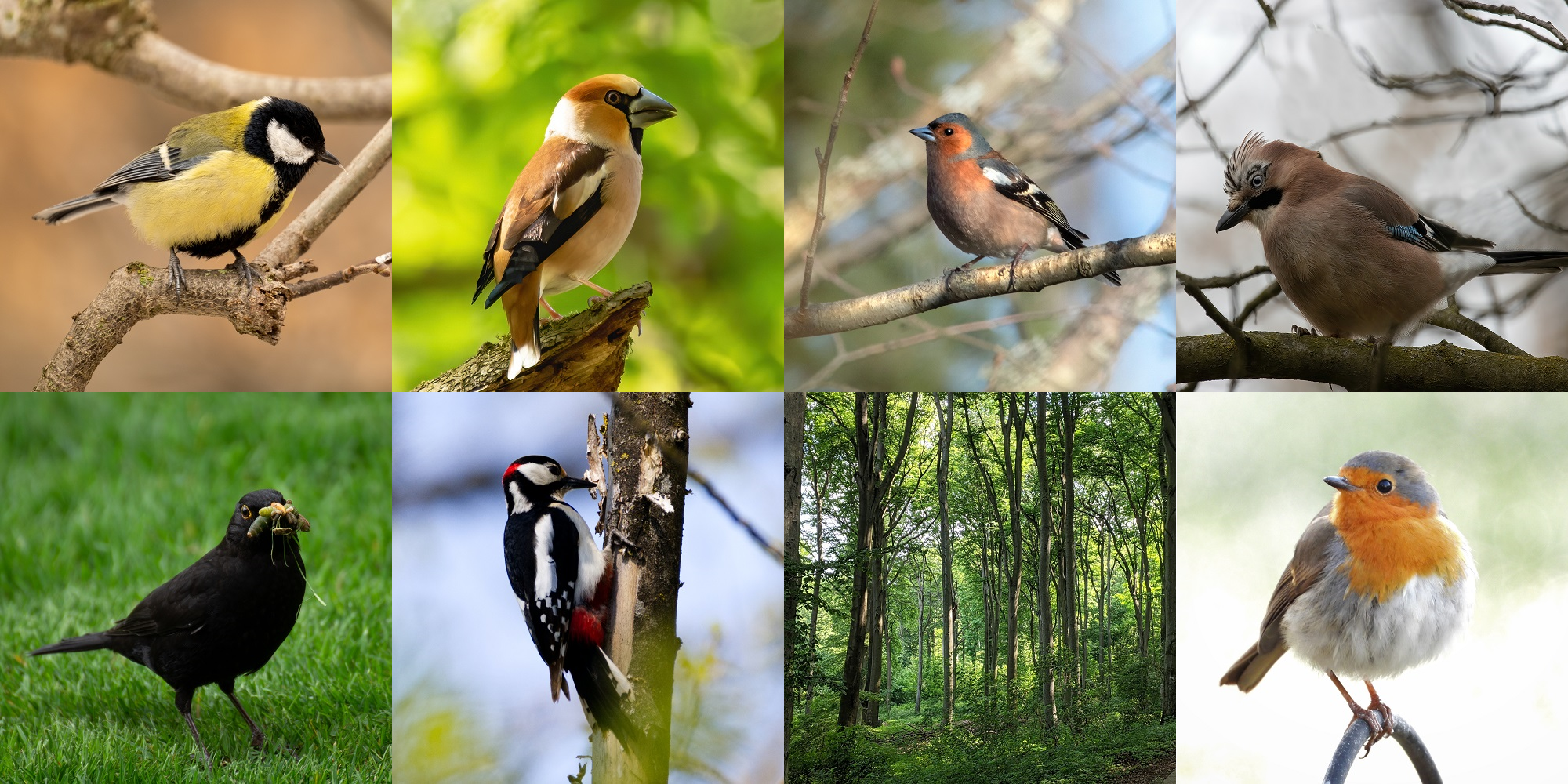
Who is chirping there?
Between the tall trunks, there's fluttering and chirping. Especially loud in spring, of course, but some typical forest birds can also be observed and heard at other times of the year. The regular drumming comes from the great spotted woodpecker. With its black, white, and red plumage, it's easy to spot as it searches for food in tree trunks. You can also spot the jay here, which particularly enjoys eating beechnuts in autumn. Another bird that likes beechnuts is the chaffinch. You've probably heard the chirping of the chaffinch before.
Listen to it, maybe you'll recognise it.
Station 10: Leaf in the wind
A fully grown copper beech bears about 800.000 leaves. Every year in spring, new tender leaves sprout from the buds. They remain on the branches until autumn, when they fall down or are carried away by the wind. A healthy leaf roof keeps the forest cool, produces vital oxygen and is home to many animals. Lie down in the leaf swing, let your eyes wander in the treetops, and gather new strength. Here you can relax like a leaf, swaying in the wind. Discover the beech trail in the different seasons of the year. Then you can witness the ever-changing forest throughout the twelve months, observing the transformation of colours, aromas, and plant life. Nearby you'll find the exercise hill, the “Trend & Fun Sports Arena” and the first station of the beech trail.
Further information
Leaves, more than just beautiful
Several hundred thousand leaves can be found on a copper beech. Beech leaves are light green, oval, and slightly soft. In these leaves, like in all leaves, energy is generated from light. Unnoticed by us humans, up to 500 litres of water, which is about four bathtubs full, flow through the leaves of a tree every day. But where does the water come from and where does it go? It comes from the soil through the roots, then flows through the trunk and branches to the leaves. This way, all parts of the tree are constantly supplied with water. So, in a way, the tree drinks. The water that reaches the top of the leaves doesn't simply fall back to the ground but evaporates into the air as invisible water vapour. In the air, the water vapour rises higher and eventually condenses into water droplets that gather as clouds and fall back to the ground as raindrops.
Leaves through the seasons
The forest changes with the seasons. In spring and summer, the forest is completely green. In autumn, the leaves of the trees turn colourful. The beech leaves first turn yellow and then light brown. But why do the leaves change colour in autumn and eventually fall off the trees in winter?
Leaves are delicate and small, making them susceptible to freezing in winter. When leaves freeze, they die and no longer serve any purpose for the tree. However, if the leaves were to fall off the trees while still green, all their valuable contents would be lost. That's why it's more beneficial for the tree to extract valuable substances from the leaves before they shed.
The tree can extract and utilise the valuable green pigment, which is the most important part of the leaf. This pigment is responsible for the green colour of the leaves. When the tree retrieves this valuable component, the leaf loses its green dye. As a result, the hidden hues that were concealed beneath the green pigment become visible. Vibrant pigments like yellow and orange come to the forefront. By retrieving and storing these valuable substances, the tree can use them to produce new green leaves in the following year, ensuring the cycle continues.

